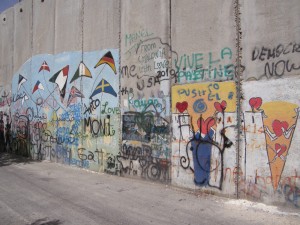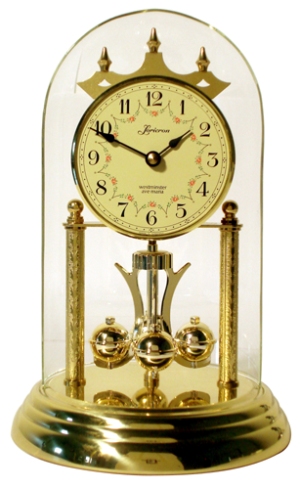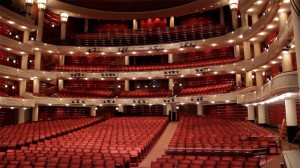From the Letter to the Romans:
Of Israel he says, “All day long I have held out my hands to a disobedient and contrary people.”
(From the Daily Office Lectionary – Romans 10:21 (NRSV) – July 12, 2014)
 Paul quotes Isaiah here. His translation was obviously rather different from the rendering in the New Revised Standard Version, but the meaning is the same: “I held out my hands all day long to a rebellious people, who walk in a way that is not good, following their own devices.” (Isa 65:2)
Paul quotes Isaiah here. His translation was obviously rather different from the rendering in the New Revised Standard Version, but the meaning is the same: “I held out my hands all day long to a rebellious people, who walk in a way that is not good, following their own devices.” (Isa 65:2)
The point cannot be made strongly enough nor forcefully enough nor clearly enough that the modern nation-state of Israel is not the biblical people of Israel, and yet these words of condemnation can be fully understood to apply to the modern country.
Having spent two weeks in the Holy Land, I’ve seen what the nation of Israel is doing to the Palestinian people, and I can fully understand (if not entirely sympathize with) the anger and frustration that have overflowed into violence. I understand the intifadas.
I have walked beside the tall, concrete, barbed-wire-topped, machine-gun-equipped, guard-tower-punctuated, grafitti-defaced wall that Israel has built through the Palestinian homeland. Israel calls it a “security barricade,” and its defenders like to point out that many stretches of it are “simply a fence” (a barbed-wire and chain-link fence, one notes). Whatever one calls it, it has ghettoized Palestinians (both Muslims and Christians), created what are essentially “reservations” of Arabs (not unlike the reservations the United States created for Native Americans), and separated people from their loved ones and their livelihoods (many farmers, herd and flock owners, and orchard owners have been cut off from and denied access to their fields, their pastures, and their orchards). Those who build such things “walk in a way that is not good” and “follow their own devices.”
The barricade is just one part of a much larger social program of oppression being practiced by the Israelis against the original inhabitants of the land they moved onto in 1948 and the lands they have occupied since 1967: poor schools, inadequate social services, intermittent (or non-existent) provision of utilities, segregation, creation of high quality roads on which it is illegal for Palestinians to travel through their own country, denial of import and export rights to Palestinian business, and the list could go on.
Why? As I listened to Israeli Jews defend this state of affairs, the bottom-line justification always seems to come back to the Holocaust. “Never again,” they say. And what they seem to mean is, “Never again to us . . . so we do it to someone else.” That’s what it is, a paying forward of bad stuff, really truly awful stuff!, done to them. When it was done to them, it was the paying forward of bad stuff done to Germany in the aftermath of the First World War. When it was done to Germany, it was a paying forward of bad stuff done to other Europeans. And one could probably trace it all back and back and back to first bad stuff done by someone to someone.
Will it stop here? If (as an Israeli commander is recently quoted as saying) the Israelis “wipe out” people seen as “enemies of God” (they aren’t, by the way) will it end? No, obviously not. Genocide has been tried before and it doesn’t work. No people can “wipe out” another, and in the current context that is painfully obvious. The Palestinian diaspora will still be there and eventually they would pay it back to Israel or pay it forward to someone else.
It will only stop, it will only end if all the people of God, all the children of Abraham — Jewish, Muslim, and Christian — can come together as equals and agree to stop it. So long as we rely on our own devices, so long as we are contrary and disobedient the conflict and the killing will go on. Only by relying on the faithfulness of God can this horror be brought to an end. As the last of today’s evening Psalms says:
Praise the Lord, all you nations;
laud him, all you peoples.
For his loving-kindness toward us is great,
and the faithfulness of the Lord endures for ever.
Hallelujah!
(Ps 117, BCP Version)
Following our own devices doesn’t and won’t work. Only relying on God’s faithfulness can and will.
====================
A request to my readers: I’m trying to build the readership of this blog and I’d very much appreciate your help in doing so. If you find something here that is of value, please share it with others. If you are on Facebook, “like” the posts on your page so others can see them. If you are following me on Twitter, please “retweet” the notices of these meditations. If you have a blog of your own, please include mine in your links (a favor I will gladly reciprocate). Many thanks!
====================
Father Funston is the rector of St. Paul’s Episcopal Church, Medina, Ohio.
 A friend and colleague preparing to sell her home and take up residence with her husband in a retirement community told me recently that she and he had begun disposing of their many possessions. Among the things to which they have said “Good-Bye” is her husband’s collection of clocks.
A friend and colleague preparing to sell her home and take up residence with her husband in a retirement community told me recently that she and he had begun disposing of their many possessions. Among the things to which they have said “Good-Bye” is her husband’s collection of clocks. Have you ever noticed how one of the most common sorts of souvenirs to be brought back from a trip is food? Every time we travel, my wife and I, we bring back food. Sometimes the authorities thwart us, but we try.
Have you ever noticed how one of the most common sorts of souvenirs to be brought back from a trip is food? Every time we travel, my wife and I, we bring back food. Sometimes the authorities thwart us, but we try. I cannot read these verses of Hebrews (nor the verses of Psalm 8 which the author quotes) without thinking of Hamlet:
I cannot read these verses of Hebrews (nor the verses of Psalm 8 which the author quotes) without thinking of Hamlet:

